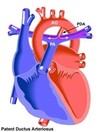Embryology of the CVS 2 Flashcards
What are the 2 methods that blood vessels develop by?
Vasculogenesis
Angiogenesis
What is vasculogenesis?
New formation of a primitive vascular network
What is the new formation of a primitive vascular network called?
Vasculogenesis
What is angiogenesis?
The growth of new vessels from pre-existing blood vessels
What is the growth of new vessels from pre-existing blood vessels called?
Angiogenesis
What is the process of the formation of the aortic sac?
1) First arteries to appear in the embryo are the left and right primitive aortae
2) Each primitive aorta has a ventral part (ventral aorta) and a dorsal part (dorsal aorta)
3) After the fusion on the two endothelial tubes the two ventral aortae partially fuse to form aortic sac
4) Aortic branches arise from the aortic sac

What are the first arteries to appear in the embryo?
Left and right primitive aorta
What is the process of the development of the pharyngael arch arteries and aortic branches?
1) Pharyngeal arches (future neck) develop during 4th and 5th week
2) Each arch receives its own nerve and artery (pharyngael arteries)
3) Pharyngael arteries communicate with aortic branches (now called aortic arches)
4) 6 aortic arches are formed on each side, all in communication with the dorsal aortae

When does the pharyngael arches develop?
During 4th and 5th week
How many pairs are present in the aortic arches?
6 pairs
What do the 6 pairs of the aortic arches develop from?
Aortic branches and pharyngael arteries
What should be noted about the aortic arches and how long they are present for?
They are not all present at the same time
Where do all of the aortic arches terminate?
Dorsal aorta
What is the fate of aortic arch 1 and 2?
Disappear early, remnant of the 1st arch forms part of the maxilary artery
What is the fate of aortic arch 3?
Common carotid and commencement of the internal carotid artery (so is named carotid arch)

What is the fate of aortic arch 4?
4th right arch forms the right subclavian
4th left arch constitutes the distal part of aortic arch
What is the fate of the 5th aortic arch?
Never forms or forms incompletely and then regresses

What is the fate of the 6th aortic arch?
Proximal part of the 6th right arch persists as the proximal part of the right pulmonary artery
6th left arch gives of the left pulmonary artery and forms the ductus arteriosus, within 1-3 months the ductus is obliterated and becomes the ligamentum anteriosum
What does the ductus arteriosus become once it is obliterated?
Ligamentum arteriosum
What are the maxillary arteries derived from?
Aortic arch 1
What is the common carotid and first part of internal carotid artery derived from?
Aortic arch 3
What is the arch of aorta (distal portion) derived from?o
Aortic arch 4 left side
What is the right subclavian artery (proximal portion) derived from?
Aortic arch 4 right side
What is the left pulmonary artery and ductus arteriosus derived from?
Aortic arch 6 left side


















